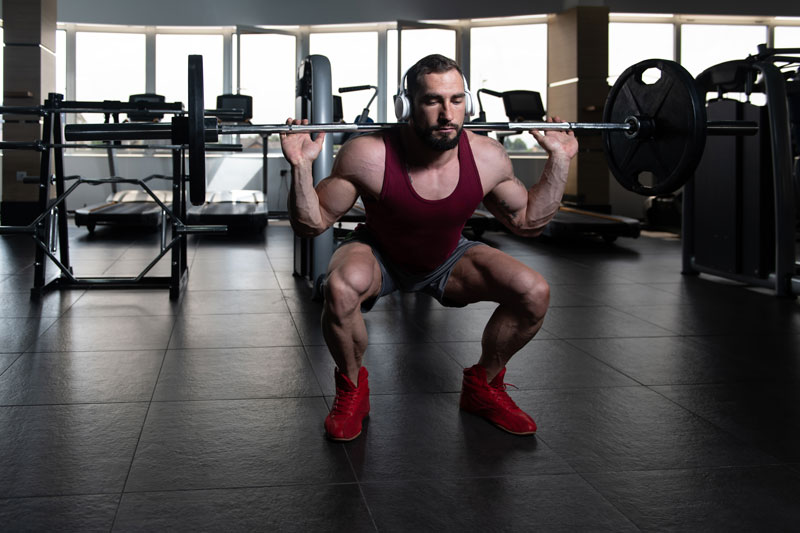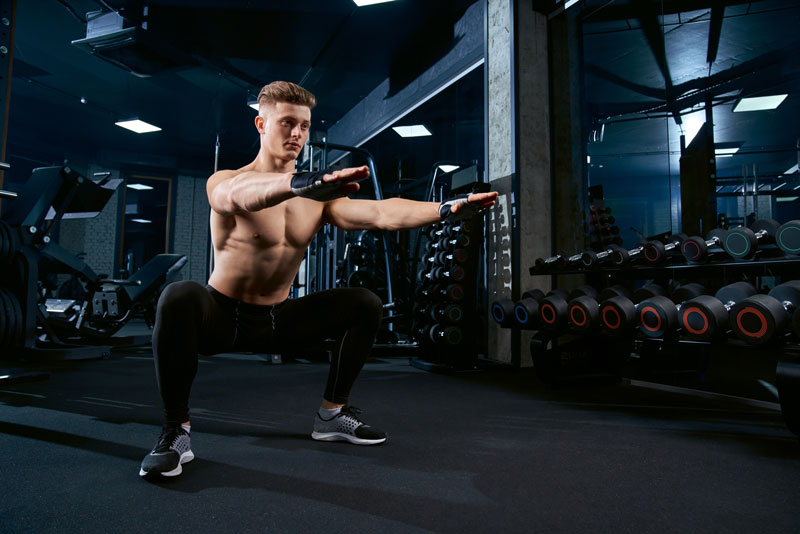You can hardly blame us for being confused. First, you see gym-goers squatting in the weight section, but then you see a cardio class going on, and they’re bashing out the squats too! So, is it to be considered a type of cardio? Or more within a strength training workout?
Typically, squats are seen as strength training, as they are a resistance exercise that builds strength and muscle in the lower body. However, it seems that depending on how you do them, they also have cardiovascular benefits. Usually, these would be associated with cardio and therefore, they can extend into both fitness types.
What’s the difference between cardio and strength training?

Before we go any further, let’s find out what cardio is and what is classified as strength training.
Cardio
Cardio is defined as anything that raises your heart and breathing rate. Well, then weight lifting could also then be classed as cardio, surely? Due to the fact that the exercise also needs to work and challenge your cardiovascular system, weight lifting isn’t cardio.
Also Read: Is your body not responding to exercise?
The goal of cardio is to improve fitness, endurance and health. We tend to think of workouts like HIIT or sports such as football or basketball. However, other types of cardio could be:
- Running
- Power-walking
- Swimming
- Cycling
Strength training
When your goal is to build muscle, strength and endurance, then strength training is what you ought to be focusing on. Much like cardio, there are obviously different types of workouts, from powerlifting (your squats and deadlifts) to hypertrophy training.
Workouts such as these allow you to use tools like the below to assist and challenge you:
- Your own bodyweight
- Barbell
- Free weights
- Weight machines
- Resistance bands
So, are squats cardio or strength training?
Squats generally seem to come under the strength training umbrella. Even if you were to do squats with just your bodyweight and no dumbbell or barbell, it is still a resistance exercise. This is because you’re using your own weight against gravity to complete the move. However, as we said earlier, you may reap some cardiovascular benefits from squats, depending on how you do them.
How to perfect your squat
There are many types of squats you can look into trying, but for the purpose of this, we’re going to focus on the good old classic squat.
Also Read: 8 mistakes to avoid whilst in training mode
A good starting point is to have your feet hip-width apart with your toes facing forward. Some people may prefer a wider or narrower stance. Engage your core and squat down, pushing your hips back. Your knees should face outwards and your shoulders, back and chest all upright. For maximum result, you’re going to want to hit that 90-degree angle with your thighs parallel to the ground. For those who are beginners, aim to get as low as possible, this is a work-in-progress. Next, push into your heels and stand up, back at the starting position. Try to make this part of the movement as powerful as possible to keep your form.
Strength-based squats

If you’re wanting to build strength and muscle in your lower body, then here are some ways to get more from your squats.
Add some weight
Ensure that you first have good form using just your bodyweight, then if so, you’re good to go with adding some weight to your workout. As you improve, you’re going to want to make ensure that you’re applying progressive overload to your training. This simply means that you’re challenging your body by making the muscles work harder than they were before. You could simply start by going from just your bodyweight to adding a 5k dumbbell and so on.
Add resistance
Including resistance bands in your workouts is a great way to improve your squats. They come in different levels allowing you to adjust to what suits you best. You’ll want to opt for one that challenges you but allows you to keep your form. There are multiple ways to use the resistance bands, such as:
- Wrap the band around your knees – this is the most popular method as it makes it harder to spread your legs, forcing you to pay more attention to your knees to make sure you don’t buckle. Extra points as this one engages more glute muscles.
- Step on the resistance band – you’ll need a longer one for this. You’ll need to stand on one end with both feet, then wrap the other end around your neck. This means that when you squat the band is loose and the resistance is when you stand back up.
Cardio-based squats
We know a little more about strength-based squats now, but what if you want to include squats into your cardio routine? Here are some ways for you to approach squats for their cardiovascular benefits.
More, more, more
Progressively overload your squats by adding in more reps and sets. Yes, this means you’ll gain strength, but you’ll also earn yourself some hearty rewards too. Especially if you’re doing a higher volume of squats.
Also Read: Ready for bigger, stronger legs?
As this is more about quantity, you don’t need to worry about adding much weight. There are some that like to aim for a number, such as 3 sets of 10 reps, or there are others who strive to do as many reps as possible, in a certain period of time. Either way, this will definitely get your heart pumping.
Add in a jump
Adding in a jump most definitely makes this more cardio than strength-based. The jump means you’ll be challenging your cardiovascular system as well as improving the power through your heels in your extension. Jumping at the top of the movement will allow for a seamless transition into the next rep.
Add pulses
Pulse squats are squats that don’t go the full range of motion. Instead, when you’re at the bottom of the squat, you pulse up and down before finishing the rep. Now, this may seem like it won’t get much of an effect, but it is a killer. It increases the burn in your lower body and makes you work just that little bit harder.
The bottom line
So, as we said earlier, squats are considered more of a strength training exercise. However, as we have now learned, amending how you execute the move can change the benefits from muscle building to better heart health. Whichever way you decide to do your squats, ensure you have the correct form to prevent injury and gain maximum results.
Are you ready to feel the burn?

If you’ve read this and now you feel pumped, we don’t blame you, go for it!
However, if you find that you’re needing a little help with your gains, then there is always Brutal Force.
Our 100% fast-acting, safe and natural formula is designed to boost your testosterone, increase your strength and help you to gain that muscle.
So if you’re ready to get BIG, order yours today!
















